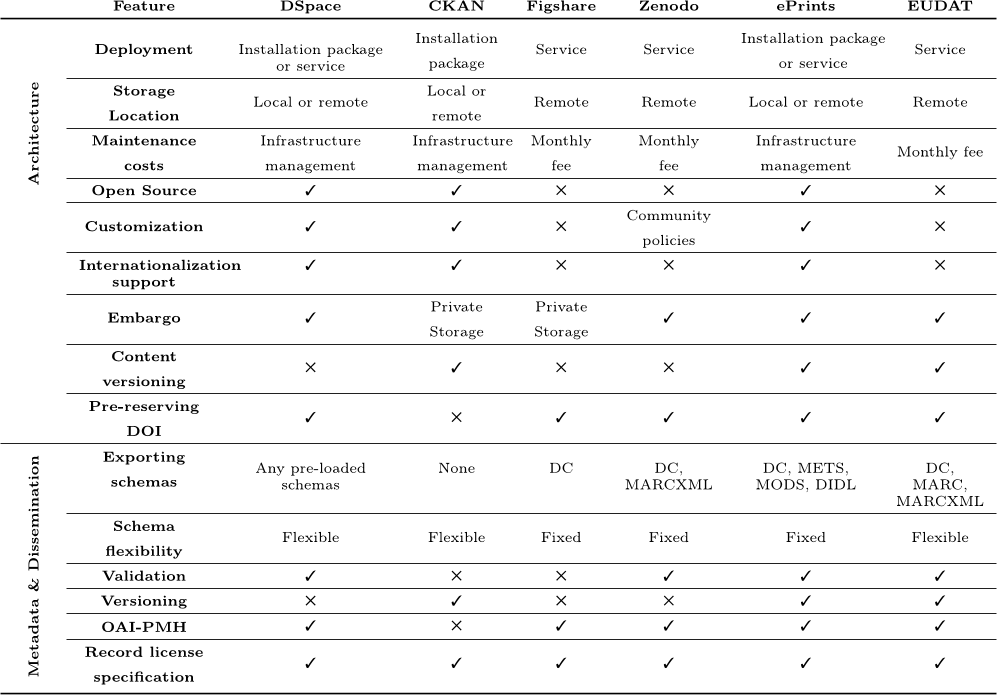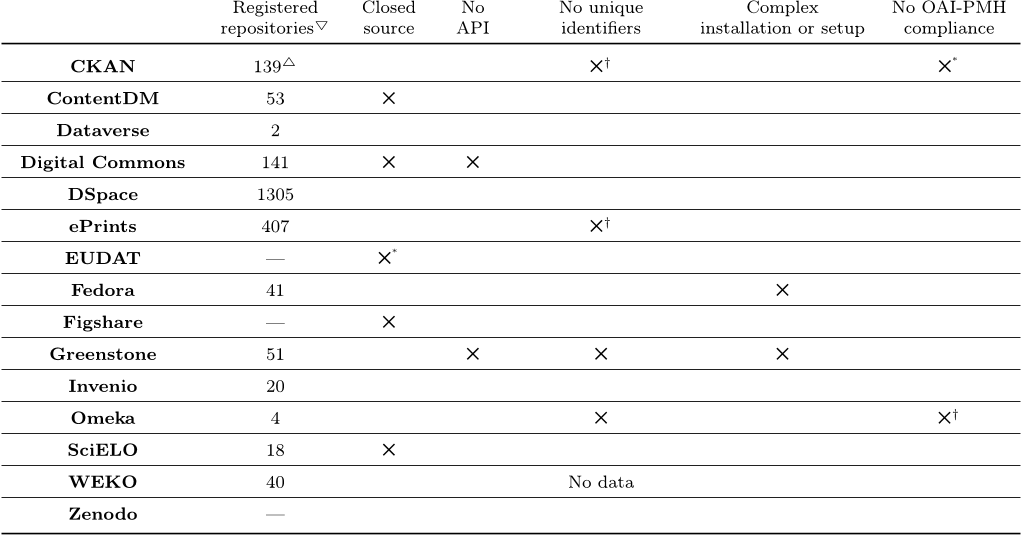2 Ricardo C arvalho Amorim, João Aguiar Castro, João Rocha da Silva, Cristina Ribeiro
stitutions. Then, focus moves to their fitne ss to han-
dle research data, namely their domain-specific meta-
data requirements and preservation guidelines. Imple-
mentation costs, architecture, interoperability, content
dissemination capabilities, implemented search features
and community acceptance are also taken into consider-
ation. When faced with the many alternatives currently
av ailable, it can be difficult for institutions to choose a
suitable platform to meet their specific requirements.
Several comparative studies between existing solutions
were already carried out in order to evaluate different
aspects of each implementation, confirming that this is
an issue with increasing importance [16,3,6]. This eval-
uation considers aspects relevant to the authors’ ongo-
ing work, focused on finding solutions to research data
management, and takes into consideration their past ex-
perience in this field [33]. This experience has provided
insights on specific, local needs that can influence the
adoption of a platform and therefore the success in its
deployment.
It is clear that the effort in creating metadata for
research datasets is very different from what is required
for research publications. While publications can be ac-
curately described by librarians, good quality metadata
for a dataset requires the contribution of the researchers
involved in its production. Their knowledge of the do-
main is required to adequately document the dataset
production context so that others can reuse it. Involv-
ing the researchers in the deposit stage is a challenge, as
the investment in metadata production for data publi-
cation and sharing is typically higher than that required
for the addition of notes that are only intended for their
peers in a research group [7].
Moreover, the authors look at staging platforms,
which are especially tailored to capture metadata re-
cords as they are produced, offering researchers an in-
tegrated environment for their manage m ent along with
the data. As this is an area with several proposals in
active development, EUDAT, which includes tools for
data staging, and Dendro, a platform proposed for en-
gaging researchers in data description, taking into ac-
count the need for data and metadata organisation will
be contemplated.
Staging platforms are capable of exporting the en-
closed datasets and metadata records to research data
repositories. The platforms selected for the analysis in
the sequel as candidates for u s e are considered as re-
search data management repositories for datasets in
the long tail of science , as they are designed with shar-
ing and dissemination in mind. Together, staging plat-
forms and research data repositories provide the tools to
handle the stages of the research workflow. Long-term
preservation imposes further requirements, and other
tools may be necessary to satisfy th e m. However, as da-
tasets become organised and described, their value and
their potential for reuse will prompt further preserva-
tion actions.
2 From publications to data management
The growth in the number of research publications,
combined with a strong drive towards open access poli-
cies [8,10], continue to foster the development of open-
source platforms for managing bibliographic records.
While data citation is not yet a widespread practice, the
importance of citable datasets is growing. Until a cul-
ture of data citation is widely adopted, however, many
research groups are opting to pu blish so-called “data
papers”, which are more easily citable than datasets.
Data pape rs serve not only as a reference to datasets
but also document their production context [9].
As data management becomes an increasin gly im-
portant part of the research workflow [24], solutions de-
signed for managing research data are being actively
developed by both open-source communities and data
management-related companies. As with institutional
repositories, many of their design and development chal-
lenges have to do with description and long-term preser-
vation of research data. There are, however, at least
two fundamental differences between publications and
datasets: the latter are often purely numeric, making
it very hard to derive any type of metadata by sim-
ply looking at their contents; also, datasets require de-
tailed, domain-specific des c riptions to be corre ctly in-
terpreted. Metadata requ ire ments can also vary greatly
from domain to domain, requiring repository data mod-
els to be flexible enough to adequately represent these
records [35]. The effort invested in adequate dataset
description is worthwhile, since it has been shown that
research publications that provide access to their base
data consistently yield higher citation rates than those
that do not [27].
As these rep ositories deal with a reasonably small
set of managed formats for deposit, several reference
models, such as the OAIS (Open Archival Information
System) [12]arecurrentlyinusetoensurepreservation
and to promote metadata interchange and dissemina-
tion. Besides capturing the available metadata during
the ingestion process, data re positories often distribute
this information to other instances, improving the pub-
lications’ visibility through specialised research search
engines or repository indexers. While the former focus
on querying each repository f or exposed contents, the
latter help users find data repositories that match their
needs—such as repositories from a specific domain or
storing data from a specific community. Governmental












